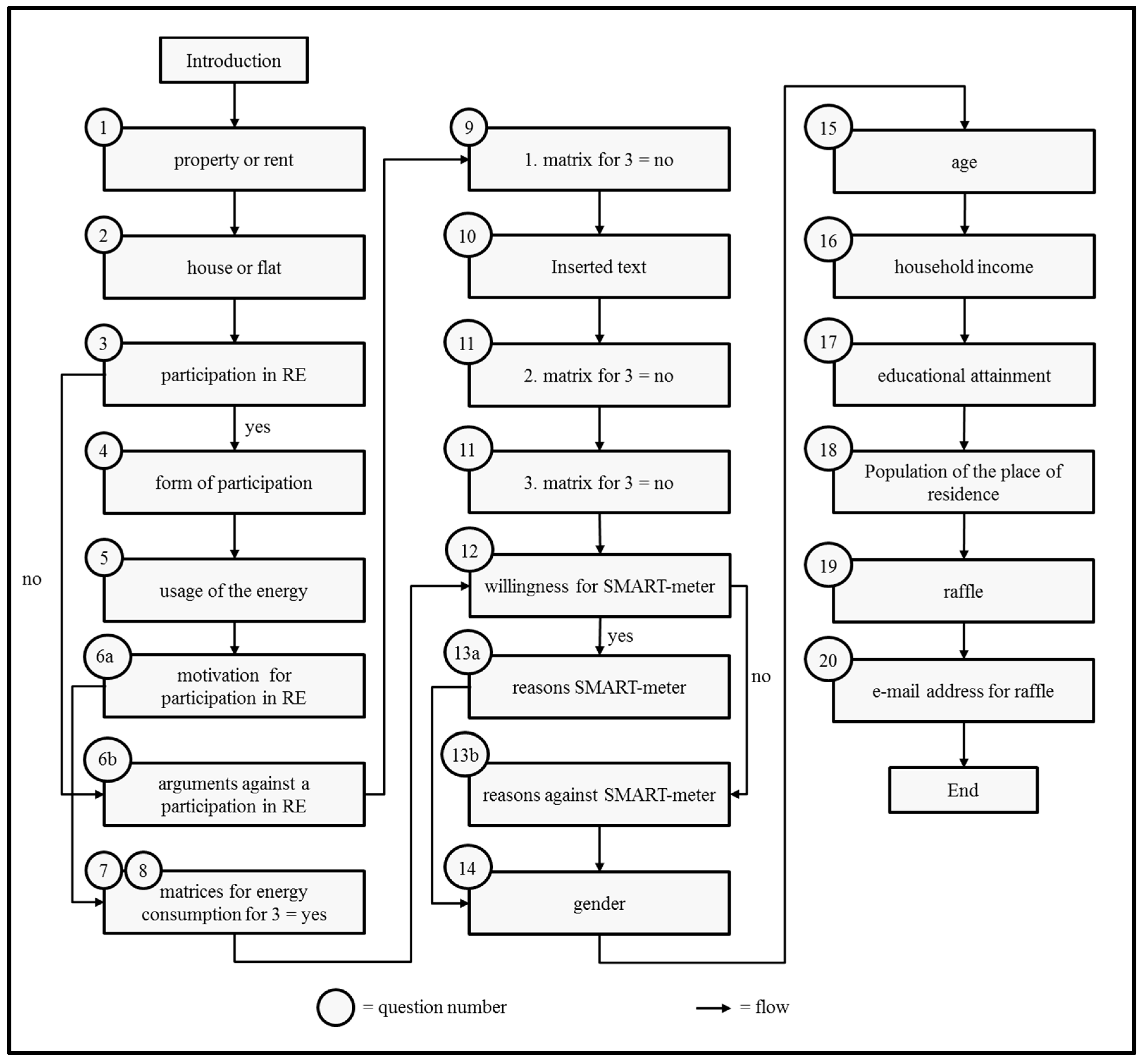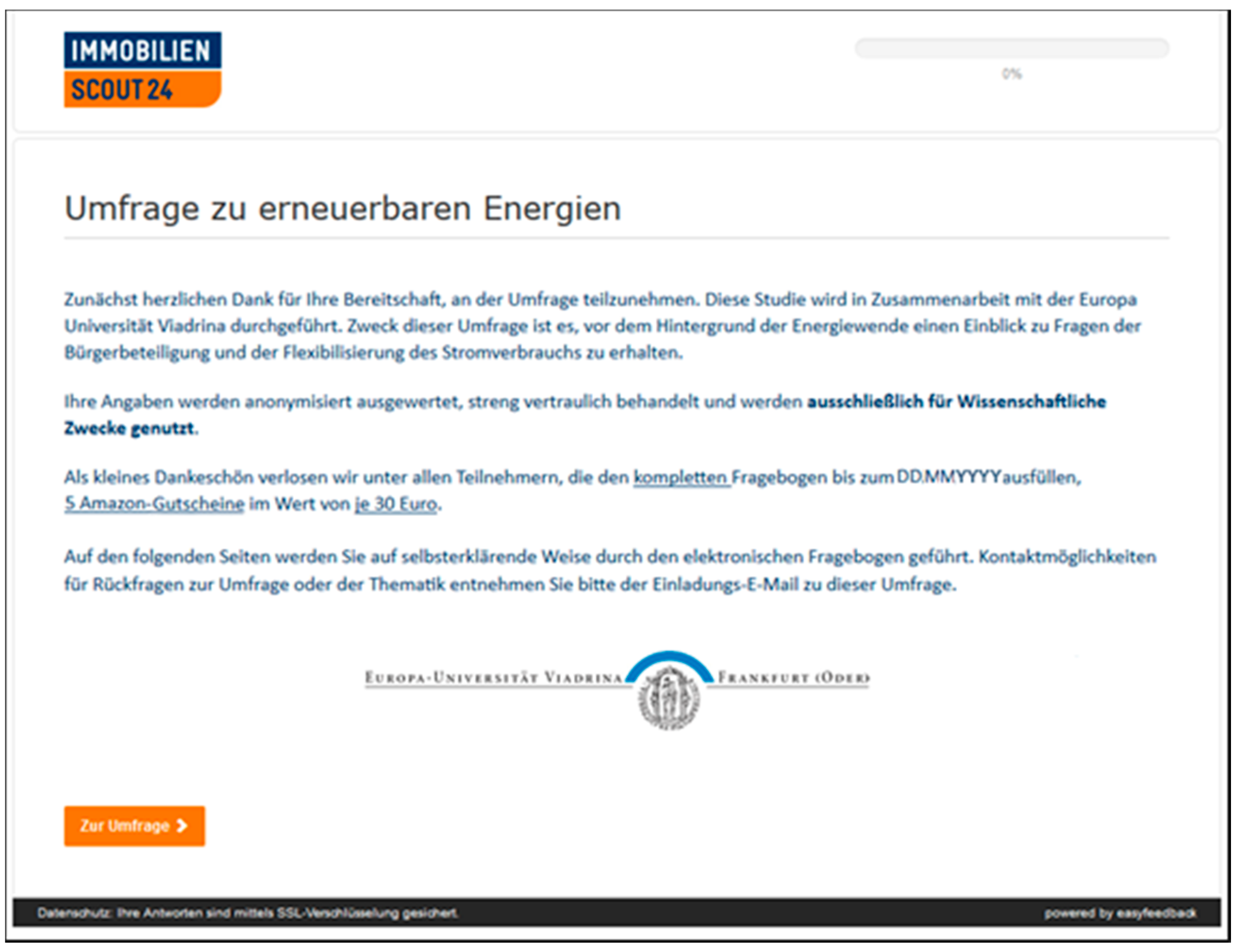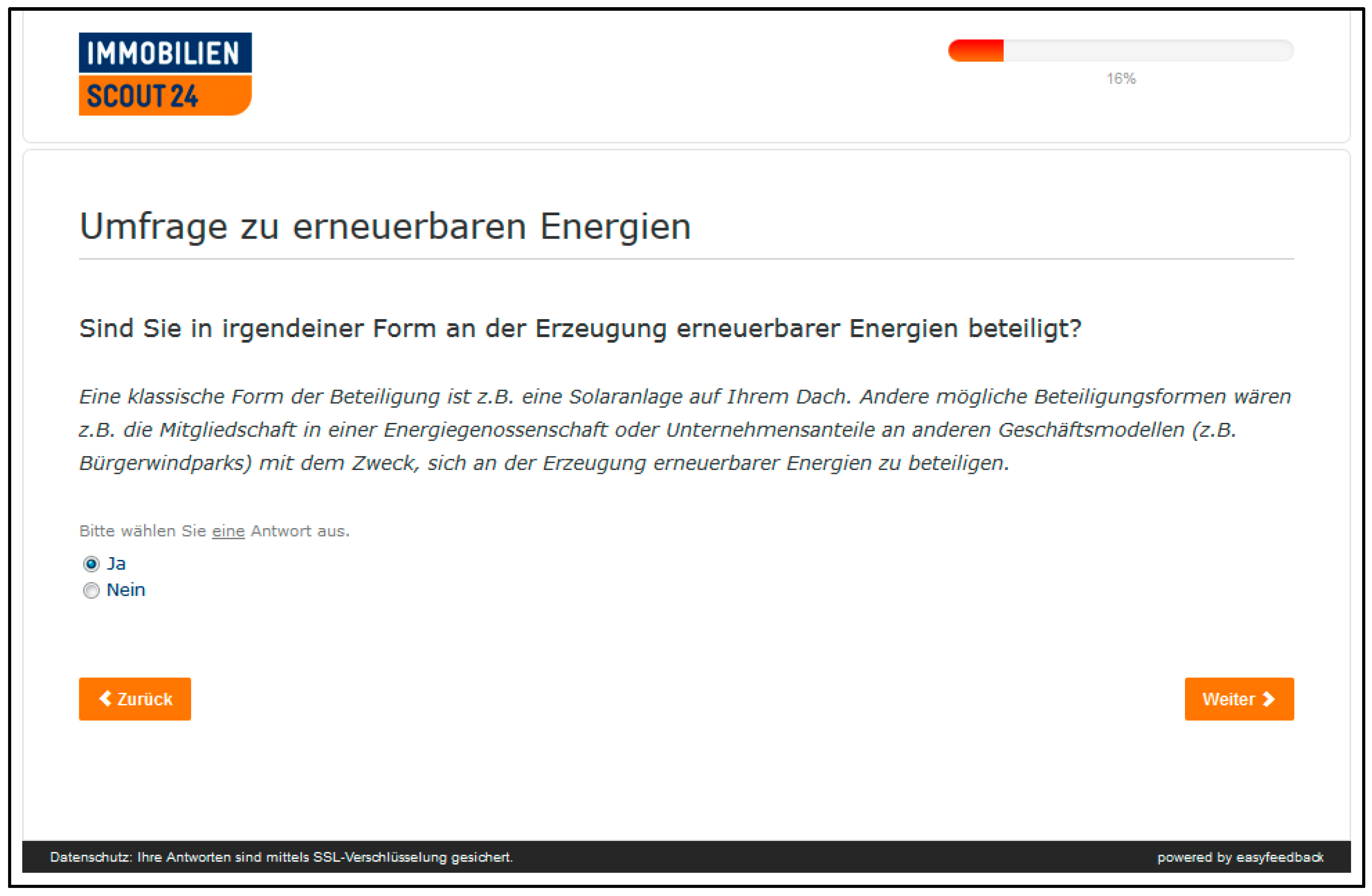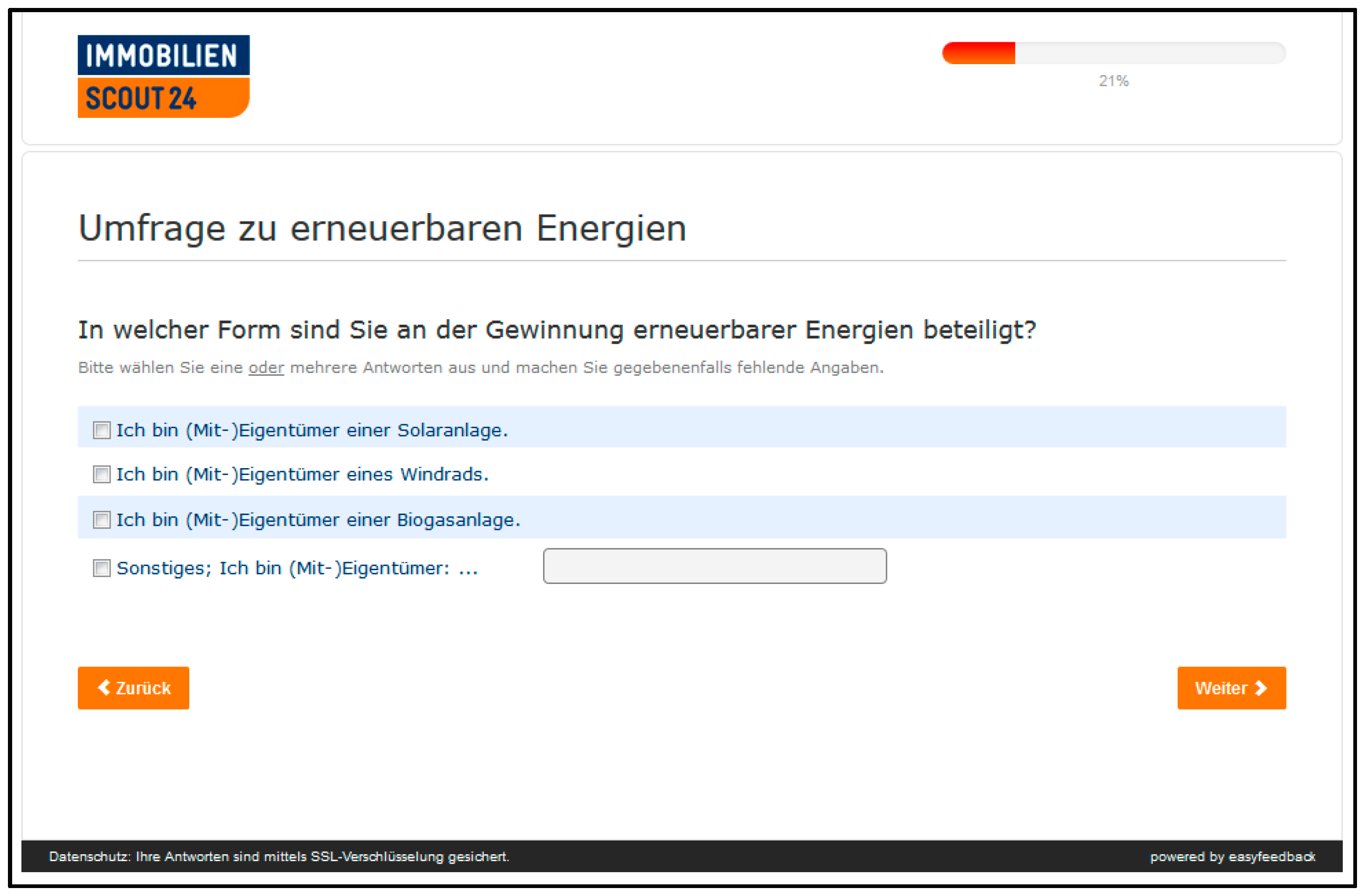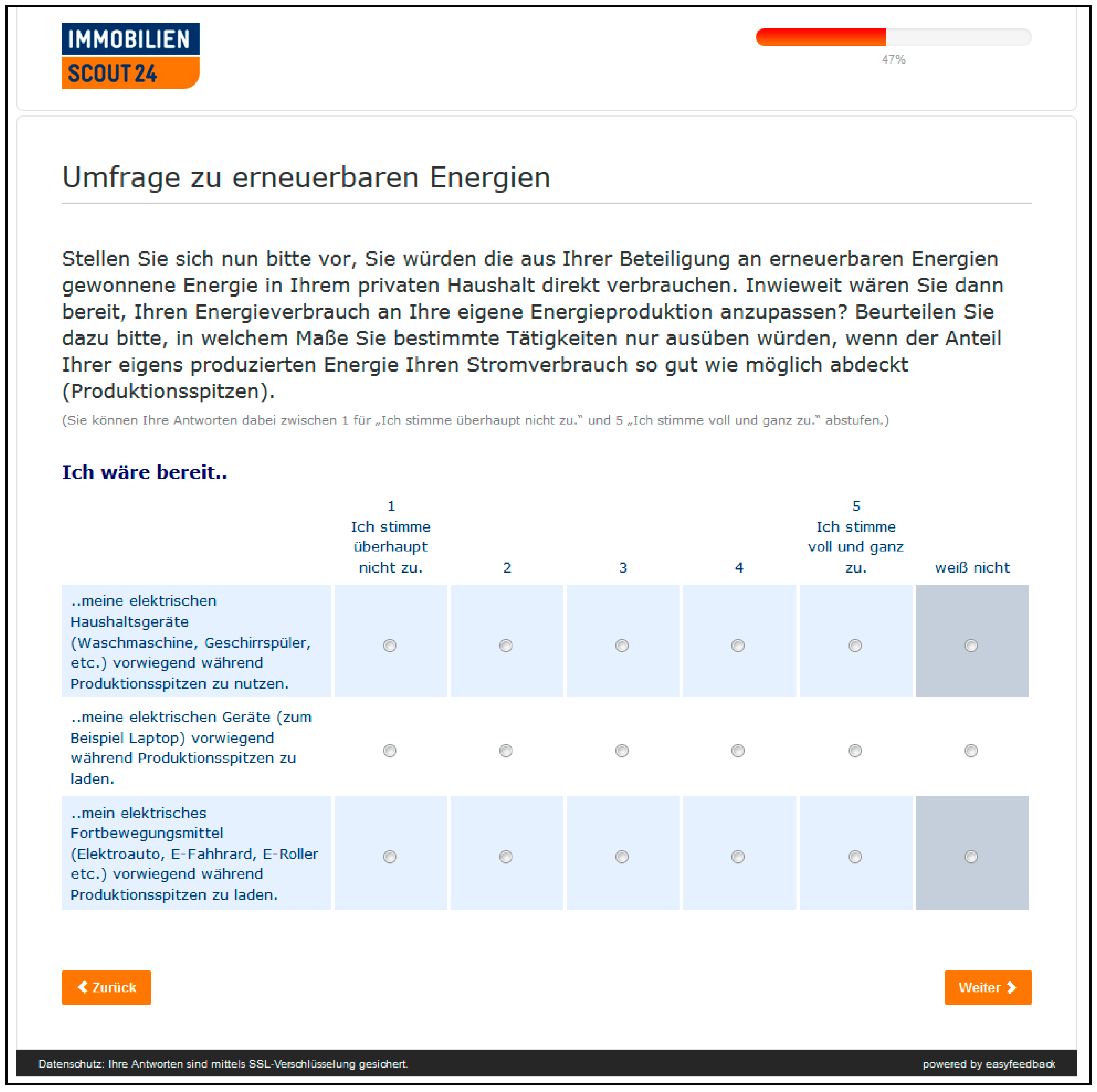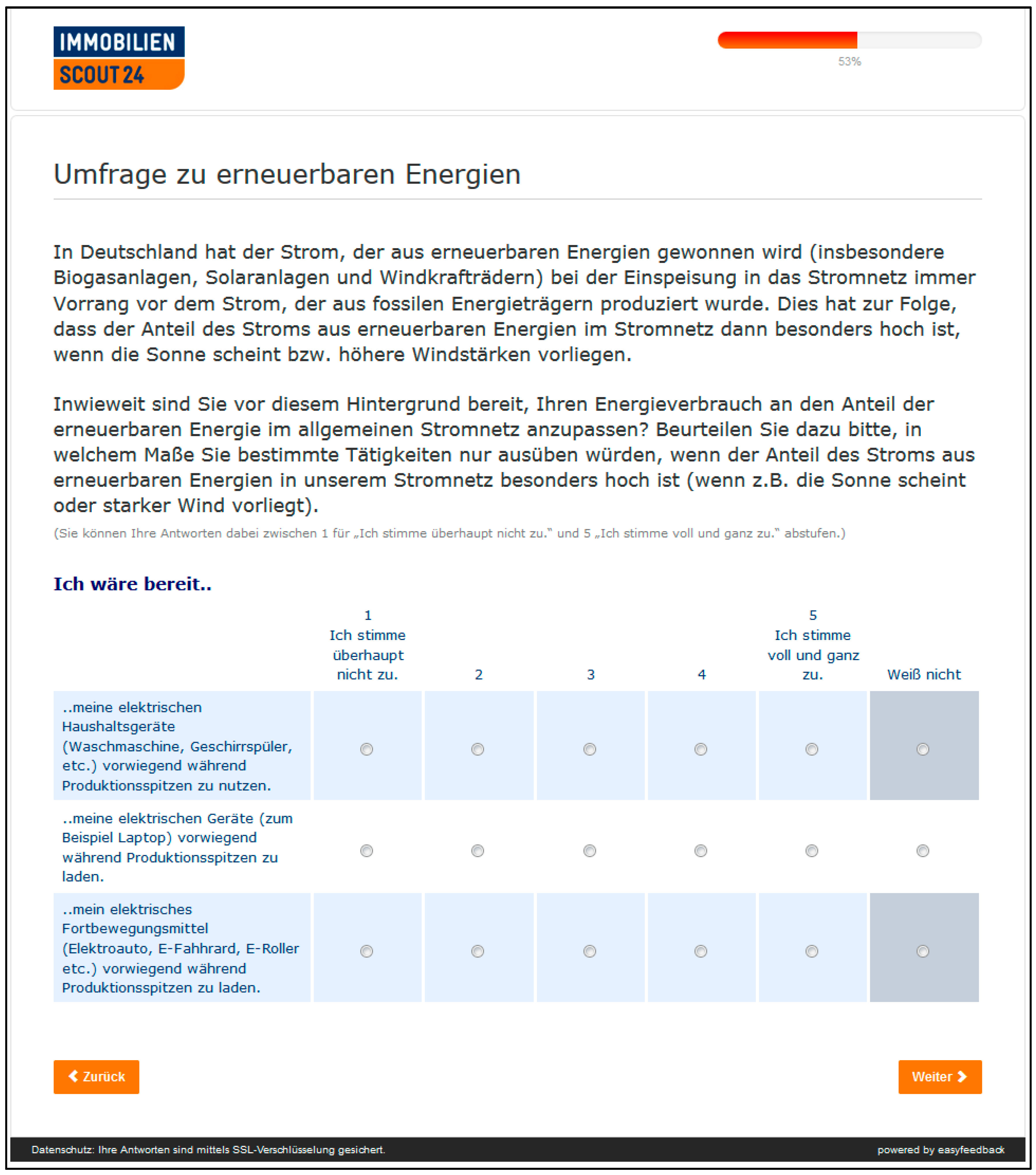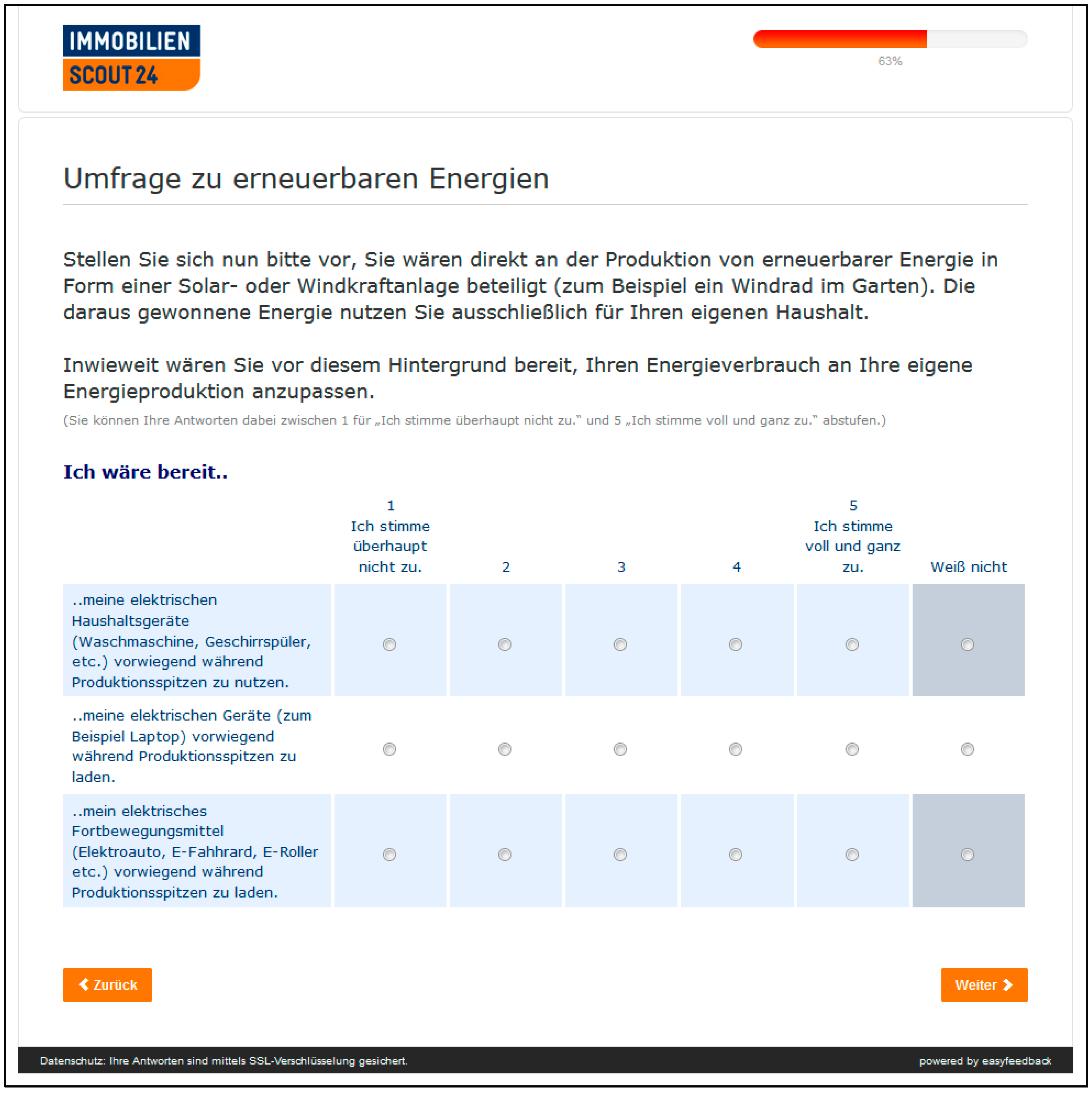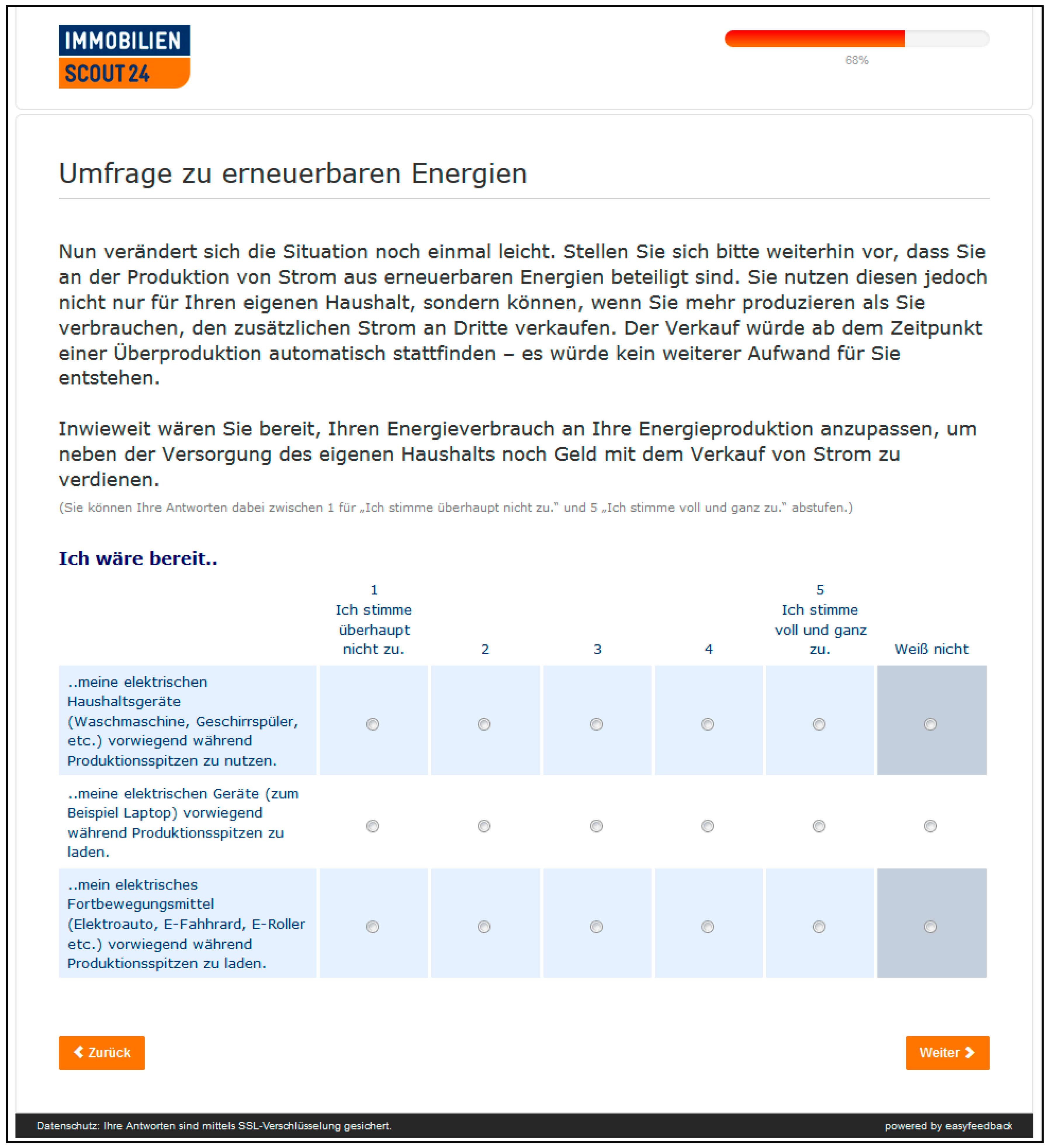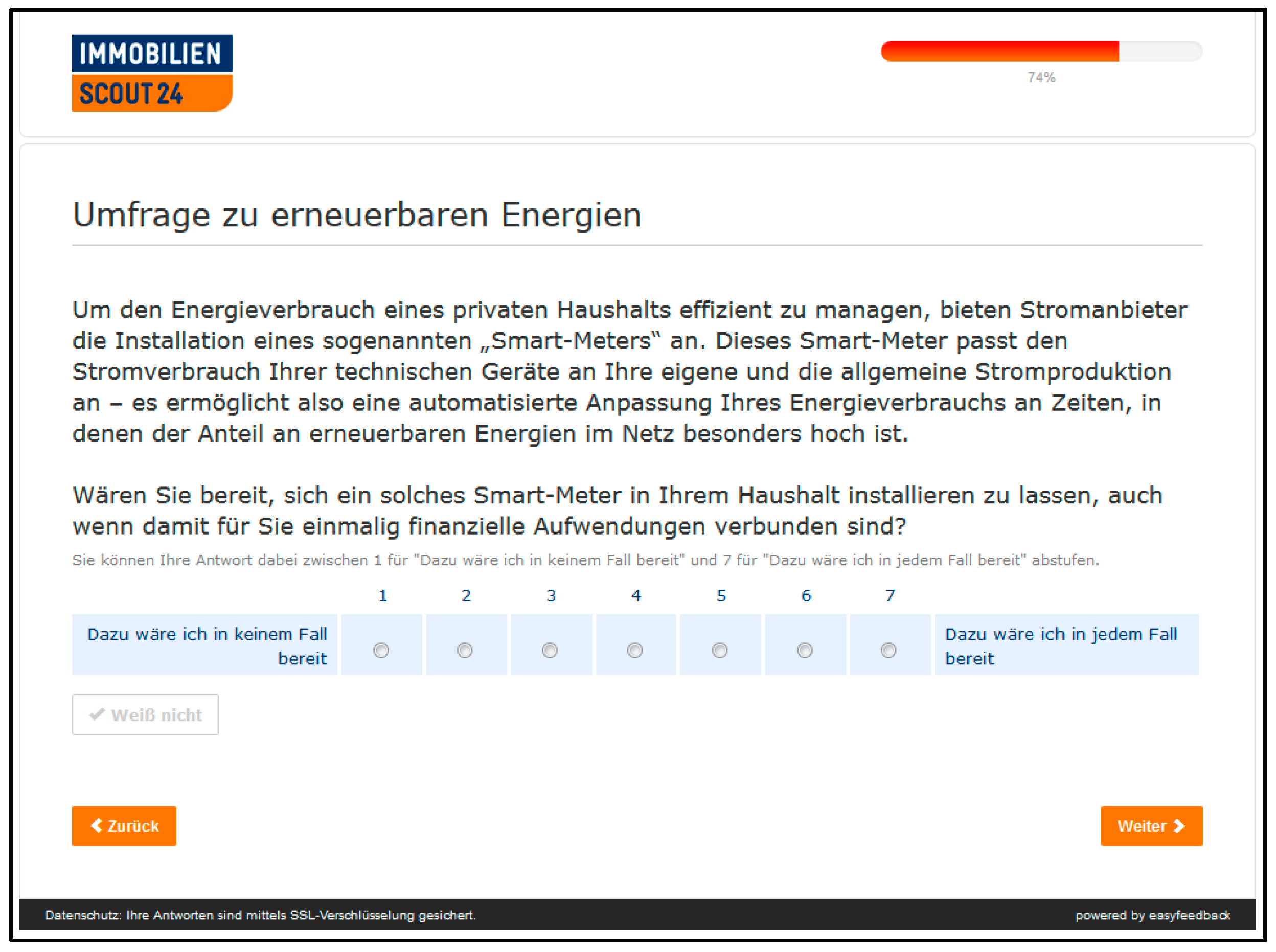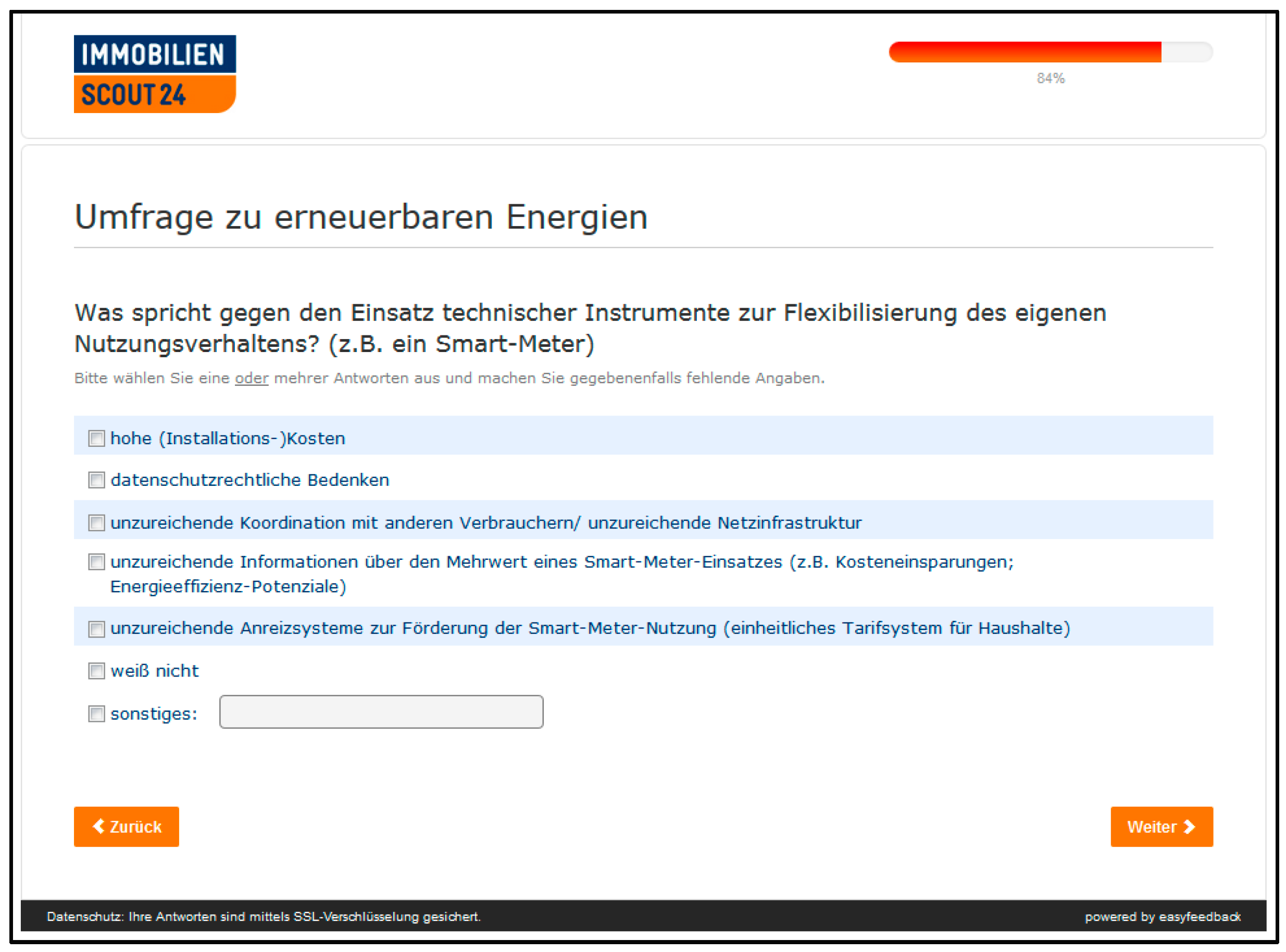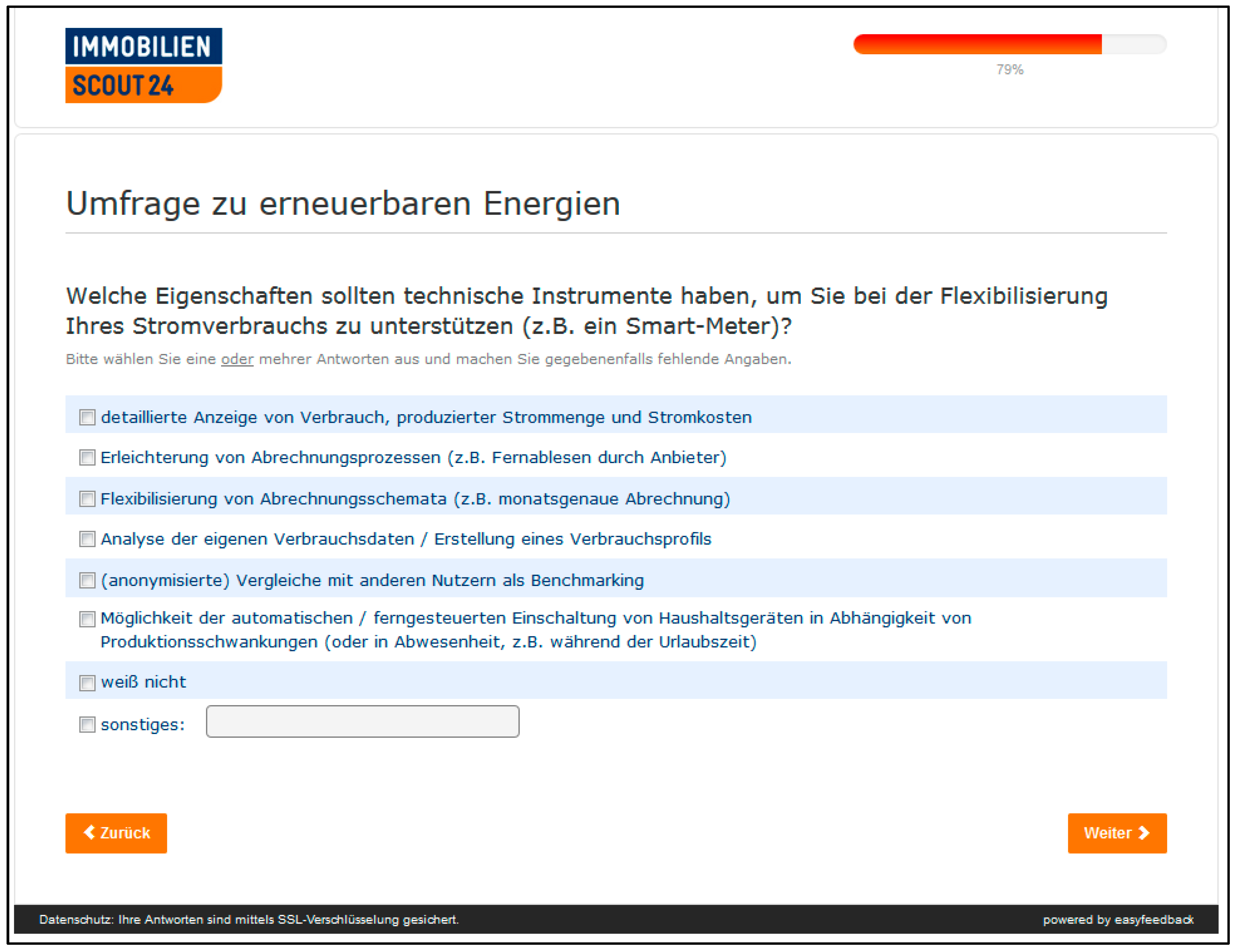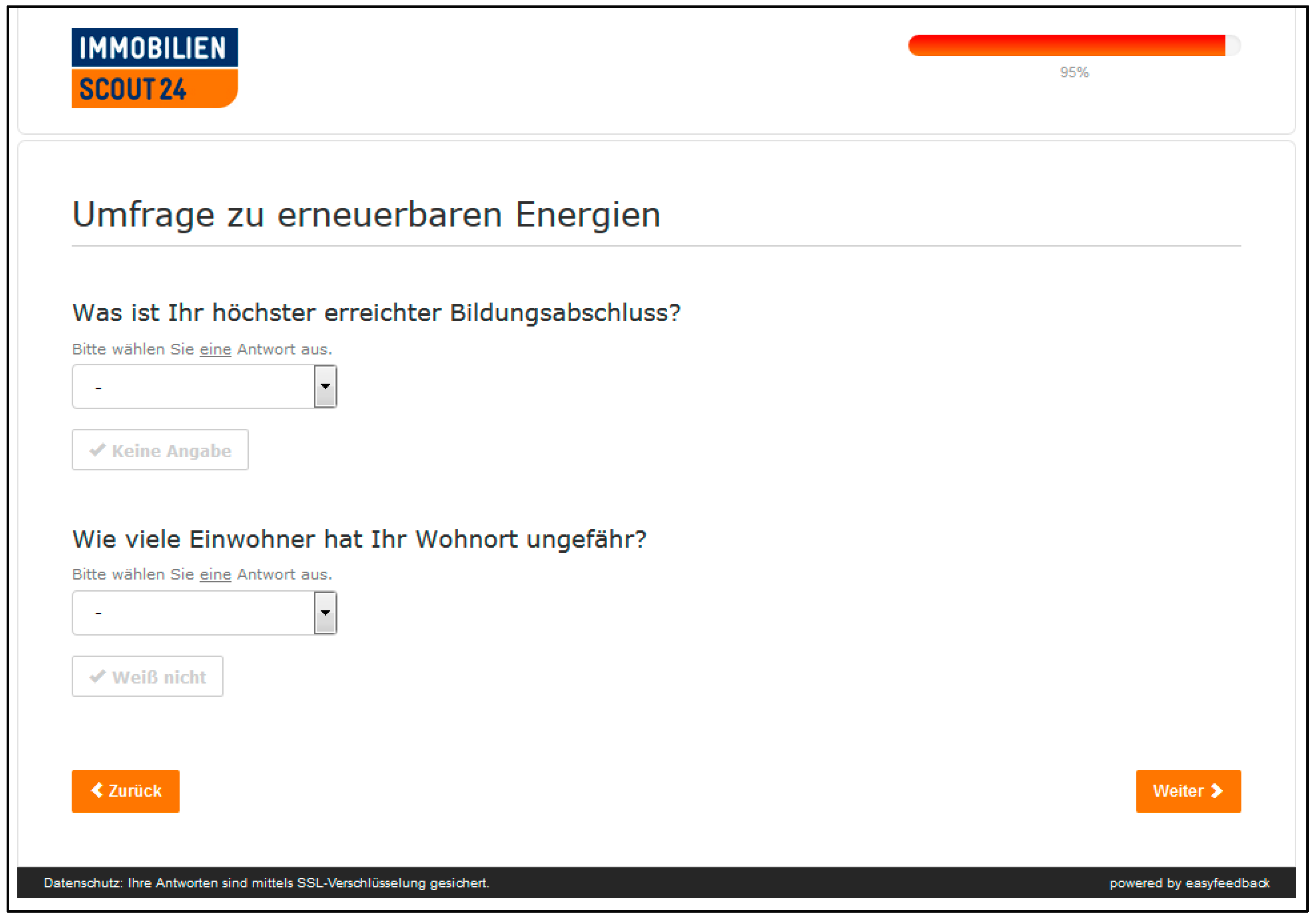Appendix C. Questionnaire Screenshots and Translation
Figure A2.
Original questionnaire: screenshot 1.
Figure A2.
Original questionnaire: screenshot 1.
Renewable energy survey
First, thank you very much for your willingness to participate in the survey. This survey is conducted in cooperation with the European University Viadrina. The purpose of this survey is to gain insight into issues of citizen participation and the flexibilisation of electricity consumption against the background of the energy transition.
Your data will be evaluated anonymously, treated as strictly confidential and will be used exclusively for scientific purposes.
As a small thank you, we will raffle 5 Amazon vouchers worth 30 Euros each among all participants who complete the entire questionnaire by the dd.mm.yyyy
On the following pages you will be guided through the electronic questionnaire in a self-explanatory way. Contact options for queries about the survey or the subject matter can be found in the invitation e-mail for this survey.
Figure A3.
Original questionnaire: screenshot 2.
Figure A3.
Original questionnaire: screenshot 2.
Where do you currently live?
Please select one single answer.
Rental.
In your own property.
Other:
Figure A4.
Original questionnaire: screenshot 3.
Figure A4.
Original questionnaire: screenshot 3.
Do you currently live in a house or a flat?
Please select one single answer.
In a House.
In a flat.
Other:
Figure A5.
Original questionnaire: screenshot 4.
Figure A5.
Original questionnaire: screenshot 4.
Do you participate in any way in the production of energy from renewable sources?
A classic form of participation is, for example, a solar installation on your roof. Other possible forms of participation would be, for example, membership in an energy cooperative or company shares in other business models (e.g., citizen wind farms) with the purpose of participating in the generation of renewable energies.
Please select one single answer.
Figure A6.
Original questionnaire: screenshot 5.
Figure A6.
Original questionnaire: screenshot 5.
In which way do you participate in the production of energy from renewable sources?
Please select one or more answers and fill in any missing information.
I am (co-)owner of a solar power plant.
I am (co-)owner of a wind turbine.
I am (co-)owner of a biogas power plant.
I am (co-)owner of a: (user input).
Figure A7.
Original questionnaire: screenshot 6.
Figure A7.
Original questionnaire: screenshot 6.
How do you use the energy generated by your installation(s)?
Please select one single answer.
Solely for own consumption
Own consumption and sale of the generated energy
Solely sale of the generated energy (e.g., through a third party)
Figure A8.
Original questionnaire: screenshot 7.
Figure A8.
Original questionnaire: screenshot 7.
What motivated you to participate in renewable energy generation?
Please select one or more answers and fill in any missing information.
Attractive alternative to classic investment opportunities
Low entry barriers (e.g., participation with small amounts of money possible or low formal effort)
Reduction of energy costs
(Partial) independence from electricity price developments
Contribution to regional value creation/strengthening of regional economy
Contribution to environmental protection
Limitation of the market power of large energy suppliers
Spatial proximity to a project in connection with renewable energies
Desire to participate in shaping (local) energy policy
Positive experiences of relatives/acquaintances with projects of this kind
Other:
Figure A9.
Original questionnaire: screenshot 8.
Figure A9.
Original questionnaire: screenshot 8.
In the following block of questions, you are asked to consider to what extent you are willing to adapt your energy consumption to your energy production. For this purpose, please assess to what extent you would only perform certain activities when the share of your own produced energy covers your electricity consumption as much as possible (production peaks).
(You can grade your answers between 1 for “I do not agree at all” and 5 for “I agree completely”. You can also choose “Do not know”).
I am willing to…
… use household appliances (e.g., washing machine, dishwasher etc.) mainly when the share of electricity from renewable sources in the grid is very high.
… recharge electrical devices (e.g., laptop) mainly when the share of electricity from renewable sources in the grid is very high.
… recharge electrical means of transportation (e.g., electric car/scooter/bike) mainly when the share of electricity from renewable sources in the grid is very high.
Figure A10.
Original questionnaire: screenshot 9.
Figure A10.
Original questionnaire: screenshot 9.
Now please imagine that you would directly consume the energy generated from your renewable energy participation in your private household.
To what extent would you then be willing to adapt your energy consumption to your own energy production?
Please assess to what extent you would only carry out certain activities if the share of your own produced energy covered your electricity consumption as much as possible (production peaks).
(You can grade your answers between 1 for “I do not agree at all” and 5 for “I agree completely”. You can also choose “Do not know”).
I am willing to…
… use household appliances (e.g., washing machine, dishwasher etc.) mainly when the share of electricity from renewable sources in the grid is very high.
… recharge electrical devices (e.g., laptop) mainly when the share of electricity from renewable sources in the grid is very high.
… recharge electrical means of transportation (e.g., electric car/scooter/bike) mainly when the share of electricity from renewable sources in the grid is very high.
Figure A11.
Original questionnaire: screenshot 10.
Figure A11.
Original questionnaire: screenshot 10.
In Germany, electricity generated from renewable sources (especially biogas plants, solar panels, and wind turbines) always has priority over electricity produced from fossil fuels when it is fed into the grid. As a result, the share of electricity from renewable energies in the power grid is particularly high when the sun is shining or there are higher wind strengths.
Against this background, to what extent are you prepared to adjust your energy consumption to the share of renewable energy in the general power grid?
Please assess to what extent you would only carry out certain activities if the share of electricity from renewable energies in our power grid is particularly high (e.g., if the sun is shining or there is strong wind).
(You can grade your answers between 1 for “I do not agree at all” and 5 for “I agree completely”. You can also choose “Do not know”).
I am willing to…
… use household appliances (e.g., washing machine, dishwasher etc.) mainly when the share of electricity from renewable sources in the grid is very high.
… recharge electrical devices (e.g., laptop) mainly when the share of electricity from renewable sources in the grid is very high.
… recharge electrical means of transportation (e.g., electric car/scooter/bike) mainly when the share of electricity from renewable sources in the grid is very high.
Figure A12.
Original questionnaire: screenshot 11.
Figure A12.
Original questionnaire: screenshot 11.
Now please imagine that you are directly involved in the production of renewable energy in the form of a solar or wind power plant (e.g., a wind turbine in your backyard). You use the energy generated from this exclusively for your own household.
Against this background, to what extent would you be willing to adapt your energy consumption to your own energy production?
(You can grade your answers between 1 for “I do not agree at all” and 5 for “I agree completely”. You can also choose “Do not know”).
I am willing...
...to use my household electrical appliances (washing machine, dishwasher, etc.) mainly during production peaks.
...to charge my electrical devices (e.g., laptop) mainly during production peaks.
...to charge my electronic means of transportation (electric car, e-bike, e-scooter etc.) mainly during production peaks.
Figure A13.
Original questionnaire: screenshot 12.
Figure A13.
Original questionnaire: screenshot 12.
Now the situation changes slightly once again. Please continue to imagine that you are involved in the production of electricity from renewable sources. However, you not only use this for your own household, but if you produce more than you consume, you can sell the additional electricity to third parties. The sale would take place automatically from the moment of excess production. There would be no further effort on your part.
To what extent would you be willing to adjust your energy consumption to your energy production in order to earn money from selling electricity, in addition to supplying your own household?
(You can grade your answers between 1 for “I do not agree at all” and 5 for “I agree completely”. You can also choose “Do not know”).
I am willing to...
...use my household electrical appliances (washing machine, dishwasher, etc.) mainly during production peaks.
... charge my electrical devices (e.g., laptop) mainly during production peaks.
…charge my electronic means of transportation (electric car, e-bike, e-scooter etc.) mainly during production peaks.
Figure A14.
Original questionnaire: screenshot 13.
Figure A14.
Original questionnaire: screenshot 13.
In order to efficiently manage the energy consumption of a private household, electricity providers offer the installation of a so-called “smart meter”. This smart meter monitors your electricity consumption and is able to automatically adjust it to your consumption. Thus, it allows for an automated adjustment of your energy consumption to times when the share of renewable energies in the grid is particularly high.
Would you be willing to have such a smart meter installed in your household, even if it meant one-time financial expenses for you?
You can grade your answer between 1 for “I would never be prepared to do this” and 7 for “I would be prepared to do this in any case”. You can also choose “Do not know”.
Figure A15.
Original questionnaire: screenshot 14.
Figure A15.
Original questionnaire: screenshot 14.
What are the arguments against the use of technical instruments to make one’s own usage behaviour more flexible (e.g., a smart meter)?
Please select one or more answers and fill in any missing information.
High (installation) costs
Data protection concerns
Insufficient coordination with other consumers/insufficient network infrastructure
Insufficient information about the added value of smart meter deployment (e.g., cost savings, energy efficiency potential)
I do not know
Other:
Figure A16.
Original questionnaire: screenshot 15.
Figure A16.
Original questionnaire: screenshot 15.
What characteristics should technical instruments have to support you in making your electricity consumption more flexible (e.g., a smart meter)?
Please select one or more answers and fill in any missing information.
Detailed display of consumption, amount of electricity produced and electricity costs
Facilitation of billing processes (e.g., remote reading by suppliers)
Flexibilization of billing schemes (e.g., monthly billing)
Analysis of own consumption data/creation of a consumption profile
(Anonymised comparisons with other users as benchmarking)
Possibility of automatic/remote controlled switching on of household appliances depending on production fluctuations (or in absence, e.g., during vacation time)
I do not know
Other:
Figure A17.
Original questionnaire: screenshot 16.
Figure A17.
Original questionnaire: screenshot 16.
Please indicate your gender.
Please select a single answer choice.
How old are you?
Please select a single answer choice.
Does your household have its own income?
Please select a single answer choice (optional).
Yes under 500 euro/month
Yes between 500 and 1000 euro net/month
Yes between 1001 and 2000 euro net/month
Yes between 2001 and 3000 euro net/month
Yes between 3001 and 4000 euro net/month
Yes between 4001 and 5000 euro net/month
Yes over 5000 euro net/month
No
Prefer not to say
Figure A18.
Original questionnaire: screenshot 17.
Figure A18.
Original questionnaire: screenshot 17.
What is your highest educational attainment?
Please select a single answer choice.
Prefer not to say
Approximately how many inhabitants does your place of residence have?
Please select a single answer choice.
Do not know.
Figure A19.
Original questionnaire: screenshot 18.
Figure A19.
Original questionnaire: screenshot 18.
Do you want to participate in the raffle of Amazon vouchers?
If you want to participate in the raffle of the Amazon vouchers, please enter your e-mail address. If you are not interested in our raffle, simply skip this question.
My e-mail address is:
Yes, I accept the conditions of participation.
Figure A20.
Original questionnaire: screenshot 19.
Figure A20.
Original questionnaire: screenshot 19.
Thank you for your participation!
You have successfully completed the survey.
You can close the browser window now.
